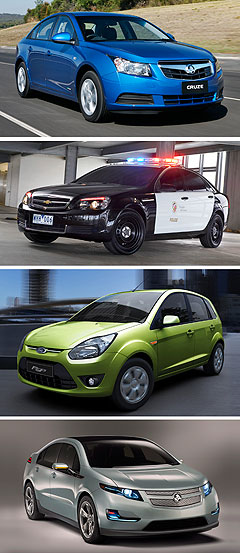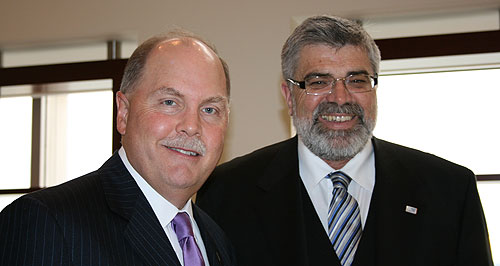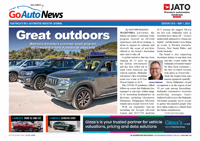Make / Model Search
News - HoldenAustralian car industry secure: CarrAssurance: General Motors CEO Fritz Henderson (left) with federal industry minister Senator Kim Carr at their meeting in Detroit. Holden's Cruze a 20-year deal for manufacturing, says federal industry minister13 Oct 2009 HOLDEN’S locally made Cruze small car should shore up General Motors manufacturing in Adelaide for at least the next 20 years as Australia continues to play an integral role in the American auto giant’s global automotive operations. That is the verdict of federal industry minister Kim Carr after leading a delegation of 20 Australian automotive industry representatives on an extensive trade tour of the US last week, during which he gained commitments from both GM and the Ford Motor Company of their continued involvement in car manufacturing here. In an exclusive interview with GoAuto this week, Senator Carr – who met with GM chief executive Fritz Henderson and Ford CEO Alan Mulally in Detroit – said there was “enormous confidence” at the highest levels in the Australian engineering and manufacturing operations of both companies. Senator Carr also said he made it clear to GM that he was determined to ensure Australia was “at the head of the queue” should the company choose to build its Volt plug-in hybrid outside the US. “The point of the trip is to reinforce the links between the Australian automotive industry and the US automotive industry at a time of great uncertainty within the United States,” Senator Carr told GoAuto.  From top: Holden Cruze, Chevrolet Caprice Patrol Car, Ford Figo, Holden Volt. From top: Holden Cruze, Chevrolet Caprice Patrol Car, Ford Figo, Holden Volt.“The message is very clear. There is enormous confidence in the quality, the breadth and the role of manufacturing in Australia for both Ford and General Motors. “There is no doubt in my mind that Detroit has the view that Australia remains a vital part of their international production systems.” Led by Senator Carr and his US automotive industry envoy, former Victorian premier Steve Bracks, the Australian trade delegation was told by senior executives from both companies that establishing specialist capabilities would allow local manufacturers and suppliers to take part in the development of environmentally friendlier vehicles on a global basis. Specifically, Senator Carr confirmed GM has committed to investing an additional $1 million into the research and development of seven different projects at the Co-operative Research Centre for Advanced Automotive Technology (AutoCRC) at Fishermens Bend – four of which will involve the CSIRO, which was also represented on the trade mission. Set up essentially to link academia with the car industry, AutoCRC includes input from Holden and several suppliers and universities. “A range of new initiatives were discussed (with GM), which highlights the growing link between the Australian automotive industry and our main scientific agencies, including our universities,” Senator Carr said. “The Automotive Innovation Council as you know has been specifically designed to put together those sorts of connections. “We’re trying to involve our scientists, our researchers, in all aspects of the automotive industry, because that is the way in which we develop a cutting-edge competitive advantage for the deployment of new technologies and new processes.” Holden would not comment specifically on the investment, but it is understood the projects include improved simulated and virtual manufacturing techniques to improve design and reduce development costs, advanced coatings and laser-based engine diagnostic technology. “In the first instance it’s modification to the internal combustion engine,” said Senator Carr. “That’s where you’ll get the most rapid change in fuel economy and emissions. “It’s not just in the drivetrain it’s aerodynamics, it’s the use of light metals, advanced electronics. Advanced engine technology is quite clearly critical.” Senator Carr said GM was able to commit to longer-term projects than Ford because Holden was at a more advanced stage in the lifecycle of its core model than Ford. “Because it’s a different period in the lifecycle of the Commodore there are commitments to future program developments with General Motors for the Commodore,” he said. Senator Carr said GM had committed to further developments of the Commodore platform beyond Holden’s newest US export hope, the recently revealed Chevrolet Caprice police vehicle. “We already know that Holden will be an integral part of the new General Motors. Talks with senior executives on this trip have given us a better picture of what this means. “Holden will remain a global centre for the development and production of hi-tech, rear-wheel drive vehicles. There were detailed discussions about future export programs and obviously the police car has been extremely well received,” he said. “The tender for the police car is going very, very well. We think there is enormous potential there and while it is a very rigorous tender process we should not assume that this is all a done deal because it is not. “The truth of the matter is that the Crown Victoria is a vehicle that is going out of production, that has dominated the police market in the US for a very long time, and it is timely that GMH has put this bid forward. “It (Holden’s Chevrolet Caprice patrol car) is an extremely good vehicle, it is priced very competitively, it is a vehicle that provides the sort of performance that the police are looking for. “Police forces want the stability, handling and safety you can only get with a rear-wheel drive vehicle – the kind of vehicle Australia makes better than just about everyone else. “They also want high performance, low fuel consumption and low greenhouse emissions. Better known to us as the Statesman, Holden’s Chevrolet Caprice ticks all these boxes. “Law enforcement agencies in the United States buy about 80,000 patrol cars a year. Capturing even a quarter of this market would be a coup for Holden. It would be an important step in the transformation of the industry, which must ultimately be export-led. “General Motors’ willingness to promote this Australian vehicle in its own backyard is proof positive of its faith in our product. Senior executives in Detroit have indicated to me that they are committed to the further development of the Commodore platform,” he said. As well as the CEO of Ford Credit and senior US economists and environmentalists, Senator Carr also met with senior members of the Obama administration. He said US government and union concerns about the prospect of domestic police forces buying an imported model would not be a deal-breaker for the Caprice patrol car. “We spoke to them about the way in which the Australian industry can work more effectively with the US industry,” he said. “There is a matter of clear tension operating at the moment … because of the pressure on the US automotive industry, where the involvement of international supply chains is a sensitive question. “However, what’s been argued is that where arrangements become mutually beneficial, then there is scope for further engagement. “We talked to them about their engagements and the extent to which their programs … their stimulus programs are often very explicitly aimed at the promotion of domestic manufacturing in the US, so as I say there is tension there in terms of the relationship with Australia. “However, those matters can be worked through where there is clear evidence of mutual benefit. “There are some reservations in the US about the use of an Australian-made vehicle, but the truth is the Crown Victoria is a Canadian-made vehicle. “There is sensitivity about it but it ought not be sufficient to render the vehicle uncompetitive,” he said. Either way, Senator Carr said Australian production of Holden’s imported Cruze sedan and its locally designed hatchback sibling in late 2010 would shore up GM manufacturing in Adelaide for the next two decades. “It’s another opportunity to broaden our capabilities, to help transform General Motors (Holden) and it should set General Motors up for the next 20 years. “The vehicle is yet to be built, so we’ll obviously see how it is received. (But) I’m pretty confident there will be export opportunities through the development of the Australian-built Cruze,” he said. The federal industry minister reiterated the potential for up to five derivatives of GM’s compact Delta platform – which forms the basis of the Cruze, Astra and Volt hybrid, which Holden has promised to sell here from 2012 – but the chances of Australian manufacturing involvement depended on each car’s financial viability. “A new fuel-efficient four-cylinder Holden will start coming off the production line at Elizabeth next year. The Commonwealth is supporting this initiative through the Green Car Innovation Fund,” he said. “General Motors engineers have pointed out that this car uses the same basic architecture as the battery-electric Chevrolet Volt, which will be launched in the United States late in 2010. “The Delta has five different capabilities. No decision has been made about whether or where the Volt will be produced outside the United States, but we are determined to make sure Australia is at the head of the queue. “The technology is compatible with the Cruze, so we’ll look at the issue of building an electric version of the vehicle as the business case is demonstrated. It’s always been part of our plan to consider that when the business case is established.” While Ford this year cancelled plans to produce its next-generation Focus small car in Australia from 2011, it has committed to a next-generation direct liquid-injection LPG system for the Falcon in 2010, and V6 turbo-diesel versions of the Territory and four-cylinder EcoBoost versions of the Falcon from 2011. Senator Carr said senior Ford officials have confirmed they are investigating further engineering programs. “Ford Australia has led the design, development, engineering and testing for the new (T6) Ranger pick-up, which will be sold in countries around the world, contributed critical design and engineering work to the new Figo small car just launched in India in collaboration with other Ford R&D centres and done all the design, development, engineering and testing for the uniquely Australian E8 platform, which underpins the Falcon sedan, the Falcon ute and the Territory,” he said. “The Commonwealth is supporting the introduction of these fuel-saving and carbon-cutting technologies (EcoBoost, diesel and LPG) through the Green Car Innovation Fund. “Ford will continue to draw on this unique R&D resource, with senior executives confirming that the company is looking at what other engineering programs can be undertaken in Australia. “While Ford have just introduced a new model and have made significant new investments in new hi-tech engine technologies, it’s not reasonable to expect them to be contemplating what they are doing next,” he said. “That’s an unrealistic question, but there’s no question about Ford’s commitment to Australian manufacturing, particularly the design and engineering centres, with the contribution they make to global platforms. “We’re working with them on better performance in terms of the inline six. They’ve just announced a series of new investments for fuel-injection systems and the diesel. So there is a range of things that are being encouraged.” Senator Carr said Australia’s wider components supply industry stood to gain much from closer ties with the US industry if it was prepared to invest in new technology. “The message from Detroit is that we can exploit this foundation by extending our capabilities in batteries, electric motors and advanced electronics,” he said. “We are already doing leading-edge work in these areas, not least at CSIRO, whose high-performance UltraBattery is currently being commercialised under licence in the United States. “We’ve got quite extensive investment in battery technologies from the CSIRO and we’ve also had quite extensive investments in bio-fuels through our research agencies, so where this goes in the future is a question that remains unresolved. “Our challenge is to translate great ideas into products and processes that will reshape the Australian car industry and take it in an entirely new direction. It is also about making the most of our leadership in design and development, which is the first thing people in Detroit want to talk about. “We need to concentrate more on batteries, electrics and light metals. We need to develop our capacity and that’s what the roadmap is doing through the Automotive Innovation Council, which has been specifically tasked with identifying strengths in terms of our capabilities and opportunities for further development. “My hope is to be able to have that ready for release at the Shanghai International Expo next March.” While the Australian trade delegation is now in the UK, the industry minister said the US component of the trip aimed to build on the strong relationship that already existed between the US and Australian automotive industries. “The Australian industry has a great reputation and many friends in Detroit,” he said. “The Australian who designed the Monaro is now designing Cadillacs for General Motors. Former Holden chief Mark Reuss is now second in charge of GM’s product development. Current Ford Australia chief Marin Burela built strong networks throughout the company during his years in the United States and Europe. “Now is the time to make the most of these links. That’s what I have been doing in Detroit. We still have a big job in front of us, but with hard work and good ideas, there is no reason why Australia cannot cement its place in the new automotive world order.”  Read more6th of October 2009  No Holden back for US exportsChevrolet Caprice police car to form basis of Holden’s single biggest export deal5th of October 2009  Official: Holden to export Commodore as US police carLucrative new US export deal emerges as Holden reveals its Stateside police car27th of July 2009  Ford Falcon EcoBoostedFalcon to plug in to global Ford plan with direct-injection 2.0-litre EcoBoost |
Click to shareHolden articlesResearch Holden Motor industry news |











Facebook Twitter Instagram